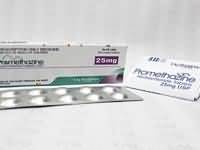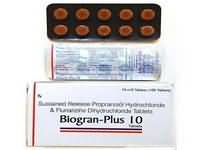Prochlorperazine

CLINICAL USE
Nausea and vomiting Labyrinthine disorders Psychoses Severe anxiety
DOSE IN NORMAL RENAL FUNCTION
Oral: 5–10 mg 2–3 times daily Buccal: 1–2 tablets twice daily IM/IV: 12.5 mg (unlicensed IV) Psychoses: Oral: 75–100 mg daily, IM: 12.5–25 mg 2–3 times dailySevere anxiety: 15–20 mg daily by mouth, in divided doses; maximum 40 mg daily
PHARMACOKINETICS
Molecular weight :373.9 %Protein binding :96 %Excreted unchanged in urine : Minimal Volume of distribution (L/kg) :23half-life – normal/ESRD (hrs) :6–9/– DOSE IN RENAL IMPAIRMENT
GFR (mL/MIN)
20 to 50 : Dose as in normal renal function 10 to 20 : Dose as in normal renal function <10 : Start with small doses, i.e. 6.25 mg IM or 5 mg orally DOSE IN PATIENTS UNDERGOING RENAL REPLACEMENT THERAPIES
CAPD :Unlikely to be dialysed. Dose as in GFR <10 mL/min HD :Unlikely to be dialysed. Dose as in GFR <10 mL/min HDF/high flux :Unknown dialysability. Dose as in GFR <10 mL/min CAV/VVHD :Unlikely to be dialysed. Dose as in normal renal function IMPORTANT DRUG INTERACTIONS
Potentially hazardous interactions with other drugs Anaesthetics: enhanced hypotensive effect Analgesics: increased risk of convulsions with tramadol; enhanced hypotensive and sedative effects with opioidsAnti-arrhythmics increased risk of ventricular arrhythmias with anti-arrhythmics that prolong the QT interval, e.g. procainamide, disopyramide and amiodarone – avoid concomitant use with amiodaroneAntibacterials: increased risk of ventricular arrhythmias with moxifloxacin – avoid concomitant useAntidepressants: increase concentrations and additive antimuscarinic effects, notably with tricyclicsAnti-epileptics: antagonised (convulsive threshold lowered)Antimalarials: avoid concomitant use with artemether/lumefantrineAntipsychotics: increased risk of ventricular arrhythmias with pimozide – avoid concomitant useAntivirals: concentration possibly increased with ritonavirAnxiolytics and hypnotics: increased sedative effectsAtomoxetine: increased risk of ventricular arrhythmiasBeta-blockers: enhanced hypotensive effect; increased risk of ventricular arrhythmias with sotalolDesferrioxamine: avoid concomitant use Diuretics: enhanced hypotensive effect Lithium: increased risk of extrapyramidal side effects and possibly neurotoxicity Pentamidine: increased risk of ventricular arrhythmiasSibutramine: increased risk of CNS toxicity – avoid concomitant use ADMINISTRATION
Reconstition
– Route
IM, IV (unlicensed), oral, buccal Rate of Administration
IM or IV over 3–4 minutes Comments
Unlicensed IV administration methods: Either: dilute with water for injection —to 5 times its own volume, and administer slowly over not less than 5 minutes,Or dilute to 1 mg/mL and administer at —rate not greater than 1 mg/minute OTHER INFORMATION
Increased CNS sensitivity in severe renal impairment.
See how to identify renal failure stages according to GFR calculation
See how to diagnose irreversible renal disease
Home









